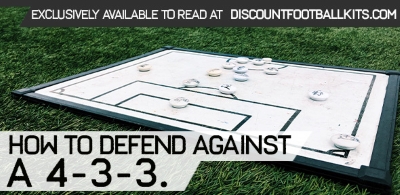If the iconic 4-4-2 formation is synonymous with the previous generation of English football, it’s the 4-3-3 shape that defines modern-day football.
This has been deployed with distinction by managers like Pep Guardiola, Jurgen Klopp and Erik Ten Hag, for example, while it offers huge merit in a tactical age of high pressing and increasingly compact defensive units.
Like all formations, however, the 4-3-3 has its own unique weaknesses that can be exploited by opponents. In this blog post, I’ll look at how you can effectively defend against a 4-3-3 shape.
1. Consider Playing a 4-2-3-1 Shape
If you’re going to beat a side deploying a 4-3-3 shape, one of the best counter formation is the similarly contemporary 4-2-3-1. This certainly affords flexibility against the 4-3-3, in a number of different ways too.
For example, your wide forwards can play very narrow and in between the midfield and defensive lines of a 4-3-3, creating central overloads by deploying two or three numbers 10s when in possession of the ball.
This creates significant passing options when structuring attacks, while these same forwards can also drift out wide during transitions to exploit the space left behind when the opposing full backs venture forward (I’ll touch on this a little further in the next section).
Even during the defensive phase of the game, a 4-2-3-1 can be adjusted to create a more rigid 4-5-1 shape, providing additional cover in the wide areas and ensuring that your team isn’t overrun in the middle of the park.
2. Play with Genuine Attacking Width and Consider the 4-4-2
If we look at how Jurgen Klopp’s Liverpool has historically deployed the 4-3-3 shape (until this season, at least), the German has encouraged his full backs to press high and provide genuine attacking width while allowing his three forwards to alternate within the width of the 18-yard box.
While this is ideal when pressing high up the park and looking to sustain attacks, it also leaves considerable spaces in behind the defensive line and in wide areas. As a result, you can counter the system with a traditional, flat 4-4-2, which deploys classic wingers and creates the potential for overloads in the wide areas.
This can not only help to nullify the attacking threat of opposing full backs, but it also creates the potential for effective switches of play when in transition and allows you to build attacks effectively when you gain possession of the ball. It also works against 4-3-3 shapes that make use of inverted full backs, as this makes teams even more vulnerable to quick and direct switches of play.
This requires discipline and significant defensive organisation, of course, while one of your strikers may need to drop into midfield if you find your side coming under pressure.
3. Make Use of a Back Three (or Five When Out of Possession)
When sides that deploy a 4-3-3 allow their forwards to press within the width of the 18-yard box, it can create an issue when playing with a flat back four. To counter this, you may want to consider adopting a three-man central defensive line, especially if you have highly capable and accomplished defenders who are able to go man-for man.
Thomas Tuchel did this superbly when setting up his PSG side to beat Liverpool in November 2018, creating a flexible defensive shape that often resembled a 5-3-2 or 5-4-1 when out of possession. When the Parisians had the ball, however, their wing backs pushed on to create a 3-4-3 or a 3-3-4 in some instances, creating attacking overloads and passing lines through which to play around the Reds’ aggressive press.
Often, the attacking quartet of Neymar, Kylian Mbappe, Edinson Cavani and Angel Di Maria would take up advanced half spaces and leave Marco Verratti as the only orthodox central midfielder when in possession, with the wing backs tucking in to go man-for-man all over the park.
This is a bold strategy that requires considerable discipline, while it also asks your attacking players to take up intelligent positions and rotate continually when in possession. You’ll also need your players to win their individual duels, so it’s not necessarily wise when setting up against superior teams.
The Last Word
The 4-3-3 is arguably the most balanced and complete formation, and one that offers both attacking and defensive strength in abundance.
It’s also a preferred system for accomplished teams that like to press high, making it incredibly difficult to defend against while also retaining an attacking threat.
As we can see, however, there are ways in which you can counter the 4-3-3 and play through (or around) the first and second passing lines, while making effective use of the space left in wide areas!










